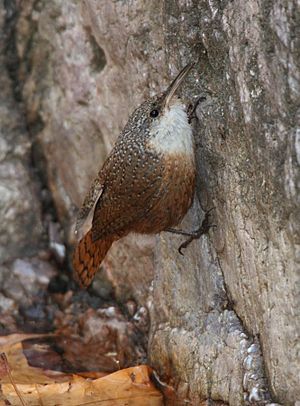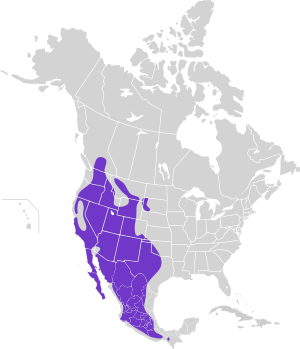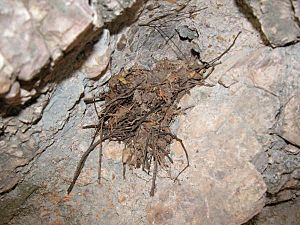Canyon wren facts for kids
Quick facts for kids Canyon wren |
|
|---|---|
 |
|
| in Madera Canyon, Arizona | |
| Conservation status | |
| Scientific classification | |
| Genus: |
Catherpes
|
| Species: |
mexicanus
|
 |
|
The canyon wren (Catherpes mexicanus) is a small, brown songbird found in North America. It belongs to the wren family. This bird loves to live in dry, rocky places like cliffs and deep canyons. Even though it's hard to spot because its colors blend in with the rocks, you can often hear its loud, special song echoing through the canyons. It's the only species in its group, called Catherpes.
Contents
Understanding the Canyon Wren's Family Tree
Scientists group living things into families. The canyon wren is part of the wren family, called Troglodytidae. For a long time, scientists debated where the canyon wren fit in this family.
How Scientists Classify Canyon Wrens
At first, the canyon wren was placed in a group with the Carolina wren. Later, it was moved to a group with the rock wren. Today, most scientists agree that the canyon wren is so unique it needs its own group. This group is called Catherpes, and the canyon wren is the only species in it.
Different Types of Canyon Wrens
Even though it's the only species in its group, there are three main types, or subspecies, of canyon wrens. These types look a little different depending on where they live:
- C. m. mexicanus: These wrens live in central and southern Mexico.
- C. m. albifrons: You can find these wrens in northern Mexico and parts of western Texas. They often have a longer beak and lighter feathers.
- C. m. conspersus: This type lives in the rest of the United States and Canada. They are usually smaller and have paler feathers than C. m. mexicanus.
Where Do Canyon Wrens Live?
Canyon wrens live in many parts of North America. They usually stay in the same area all year round.
Canyon Wren Habitats Across North America
You can find them from southern British Columbia in Canada, south through Idaho, Montana, Wyoming, and Colorado. Their range continues through much of Mexico, all the way to western Chiapas. They also live as far east as southwest Oklahoma and in west-central Texas. Some smaller groups of canyon wrens live in places like the Black Hills of South Dakota. In winter, they might gather in warmer areas like the Chihuahuan Desert in southwest Texas.
Preferred Homes of the Canyon Wren
Canyon wrens love rocky places. They prefer steep cliffs and deep canyons, especially in dry areas. Sometimes, you might even spot them near buildings, woodpiles, or rock fences that offer similar rocky environments.
What Do Canyon Wrens Eat?
Canyon wrens are insect eaters! They hunt for small insects and spiders.
How Canyon Wrens Find Food
They use their long, thin beaks to poke into tiny cracks and holes in rocks. This helps them find hidden bugs and spiders. They even get most of the water they need from the insects they eat.
Life and Habits of the Canyon Wren
The canyon wren is known for its unique song and clever way of building nests.
The Canyon Wren's Distinctive Song
This bird is often heard more than it is seen. Its song is a beautiful series of falling whistles. It's one of the most familiar bird calls you'll hear in the canyons of the western United States.
Building a Home: Canyon Wren Nests
Canyon wrens build their nests in rock crevices. They make a cup-shaped nest using small twigs and other plant materials. Female wrens usually lay 4 to 6 eggs. These eggs are white with reddish-brown and gray speckles.
See also
 In Spanish: Cucarachero barranquero para niños
In Spanish: Cucarachero barranquero para niños



